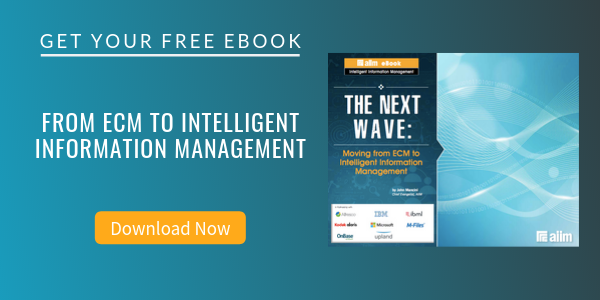
What’s in Your ECM and ERM Systems?
Electronic Records Management (ERM) | Enterprise Content Management (ECM)
In this series of interviews, we've been chatting with The AIIM Conference sponsors to get a preview of their upcoming sessions. Here, I sat down with Brian Tuemmler from Nuix. We explore some of the shortcomings of Enterprise Content Management (ECM) systems and implementations. Brian talks about some clever new ways to approach ECM and how Nuix can help.
What's in Your ECRM System?
Brian Tuemmler is an Information Governance Program Architect with Nuix.
JM: How do you see the value that Information Governance can deliver to organizations?
BT: A popular topic of discussion among the community of information professionals is what information governance (IG) can do for your records and information management program. IG tools that provide Information Transparency™ into your dark data can help you solve known problems and a bunch of new problems you didn’t know you could fix. IG can also help you with enterprise content and records management (ECM or ECRM) systems in ways you probably didn’t know were possible.
JM: What has gone wrong with ECM along the way?
BT: A recent blog from “Info Gov Guerrilla” Christian Walker, called “ECM Isn’t Delivering," explores some of the shortcomings about ECM systems and implementations. Walker writes, “The stuff I want to see is still the exception; getting value out of information and solving business problems.”
I have been an ECM consultant for a large portion of my career, and I would mostly agree that ECM has not delivered these high-level benefits for many companies. It has succeeded, however, where the perceived benefits of greater control outweighed the expected costs of getting the content into a repository. The problem is that most of your content doesn’t rise to this level.
As Chris wrote, “If an organization doesn’t have the processes and will to get their information under control and leverage it, spending butt-loads on software will get them nowhere.”
JM: What does Nuix do to address this problem?
BT: As it turns out, companies are figuring out interesting and innovative new solutions for this problem using Nuix. Nuix is not an ECM solution (nor are we consultants), but our customers are breathing more value into the ECRM space.
As a bit of background, Nuix will crawl though your shared drives, email systems, SharePoint sites, Notes databases, and other collections to build an inventory of what is there, so you can go explore and act upon what you find. Once you have this ability, you can suddenly use that information to grow—and measure—your success with ECM in some pretty clever ways.
There are two ways to get more content into an ECM:
- Increase the value of the data you migrate
- Lower the cost of migration.
You can achieve both by eliminating from consideration any content that will not benefit from ECM. One manufacturing company is using Nuix to cull out non-records, non-content, non-collaborative, un-secure, and non-capturable content before users ever get involved. The company is then tagging the remaining, relatively more valuable content with metadata to increase its usability in the new ECRM. In other words, don’t assume you need to move everything to the ECRM; be selective, but maximize your value.
ECRM is not a successful technology until it has content. People want to know if they are maximizing their investments, and the evidence for that resides in the existing unstructured content. Nuix can help you establish value, prepare ECRM strategies, and assist with migration as part of a larger IG program.
JM: Can you give me some examples?
BT: A large financial institution has been using a records classification team to classify content when moving it into an ECRM. The company asked Nuix to help judge the success and accuracy of that classification. In short, the records team wants to know what has been classified, what was misclassified, and if they are improving with training. In general, I would argue that the machine should do the classification and humans the validation, but this is an interesting way to judge the value of their effort.
A large construction manufacturer wanted to benchmark its progress in migrating content to the ECRM system. The migration team wants to generate a quarterly trend report to department heads. They know that migration occurs but want the business metrics to show how well. In other words, “We know what to do; we just don’t know how well we are doing it!”
About John Mancini
John Mancini is the President of Content Results, LLC and the Past President of AIIM. He is a well-known author, speaker, and advisor on information management, digital transformation and intelligent automation. John is a frequent keynote speaker and author of more than 30 eBooks on a variety of topics. He can be found on Twitter, LinkedIn and Facebook as jmancini77. Recent keynote topics include: The Stairway to Digital Transformation Navigating Disruptive Waters — 4 Things You Need to Know to Build Your Digital Transformation Strategy Getting Ahead of the Digital Transformation Curve Viewing Information Management Through a New Lens Digital Disruption: 6 Strategies to Avoid Being “Blockbustered” Specialties: Keynote speaker and writer on AI, RPA, intelligent Information Management, Intelligent Automation and Digital Transformation. Consensus-building with Boards to create strategic focus, action, and accountability. Extensive public speaking and public relations work Conversant and experienced in major technology issues and trends. Expert on inbound and content marketing, particularly in an association environment and on the Hubspot platform. John is a Phi Beta Kappa graduate of the College of William and Mary, and holds an M.A. in Public Policy from the Woodrow Wilson School at Princeton University.



